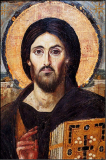We welcome all who seek God, and we love to welcome visitors to our Church. Since Orthodox Christianity is unfamiliar to most people in this area — it was new to many of us as well — we have written this to help you know what to expect.
What You will Find
On Sunday morning we usually have around 30 people in Church, including some children. The Divine Liturgy, which lasts approximately 1- 1/2 hours, expresses the entire Christian faith in a continuous song of praise and prayer to God. Since it is focused on God, we do not seek to be amusing or entertaining. Much of the service is the same every week, so worshippers can learn it easily and participate, by singing along or by prayerful attention. Worshippers are surrounded by icons (pictures of Christ and the saints), which remind us that we are participating on earth in the worship of all the angels and saints in heaven. The entire service (except for the sermon) is sung or chanted in melodies of Russian origin. No musical instruments are used. The words are from Scripture or ancient Christian texts. All our services are in English, with a few short parts done in languages of some traditional Orthodox cultures out of respect and gratitude for their preservation of the faith.
The Divine Liturgy
The normal Sunday morning service is called the Divine Liturgy. With sermon, it lasts about an hour and a half. It includes a series of litanies (petitions), praises - from the Psalms and the Beatitudes; a procession with the Gospel Book; hymns to the Triune God and for the saints of the day; readings from the Epistles and Gospels; a homily (sermon); the Great Entrance - a procession in which the clergy carry the gifts of bread and wine to the Altar; the Nicene Creed (the symbol of the Faith); the Eucharistic prayer; the Lord's Prayer; Communion; and hymns of thanks for the reception of Communion.
A Word about Communion
Only duly prepared Orthodox Christians are permitted to receive communion - the Eucharist. For us it is a visible sign of unity--with the Church and with other Orthodox Christians. We believe that to receive it in a community to which one does not belong is improper. If one does not accept all that the Churches believes, teaches and worships, one is not united with the Church. In other words, in Orthodoxy, the Eucharist is the result of unity, not the means by which unity is achieved.
Incense, candles and vestments are part of the imagery of heavenly worship in the Book of Revelation. In the Liturgy we participate in the worship of the angels and saints in heaven. Many people buy candles and place them in the church as an offering of light to the Lord, who told us to let our light shine.
Standard, formal prayers and hymns are used rather than extemporaneous or modern ones because they contain the accumulated insights of many centuries of Christians, and most of them are packed with Biblical quotations. They are repetitious because that way they become rooted in our hearts. They are chanted or sung rather than spoken so that our conversation with God will be special and so that we do not focus on the personality of the individual reader or chanter.
The Church Building and Worship
Normally an Orthodox Church is divided into three distinct parts: Narthex (entry way), Nave (sanctuary) and Altar. The narthex symbolizes the created world, made and blessed by God in the beginning as “very good,” but now fallen. The nave (sanctuary) constitutes the Mystical Body of Christ, made up of Her members both past, present, and yet to come. The Altar area, joined to the nave by an icon screen (iconostasis) shows the Kingdom of God—the Kingdom to come, but in Christ and the Church it is a reality already accessible to the faithful. The central, or “Royal,” doors of the iconostasis lead from the nave to the Altar Table, the Throne of God. On the left side of these doors is an icon of the Incarnation, the first coming of Christ as a Child, born of the Virgin Mary. On the right side of the Doors is an icon of Christ as He will appear on the Last Day, in glory. In front of the Royal Doors the faithful receive the Eucharist, partaking of the Messianic Banquet to come, and are united to Christ.
Icons
Icons (Greek: image) on the walls of the church depict scenes from the Holy Gospel, sacred Church history, or saints. Icons are also placed on stands in the church for veneration by the faithful. Icons are not merely decorative art. They are neither subjective nor sentimental, but a window into the spiritual world. Veneration is not to the paint or wood of an icon but to that other world from which shines Christ Himself.
Many customs are important parts of Orthodox worship. Although some of these are shared with Protestant and Catholic faith traditions, many are unique to Eastern Christianity. The information below is meant to help newcomers understand the behavior they are seeing during services, but not to feel pressured to conform in all things.
You will immediately notice that in our church, most people stand for worship. (In Orthodox countries there are usually no pews in the churches, just chairs or benches on side walls.) However, those who need to sit for any reason - fatigue, illness, infirmity, pregnancy - are always welcome to do so. For those who wish to know, the most important time to stand is during the reading of the Gospel. Newcomers are not required to stand throughout the entire service, and are often not used to standing that long. Please feel free to sit down at any time if you need to.
Also see: About Orthodoxy | Our Parish | More Resources | Return Home




